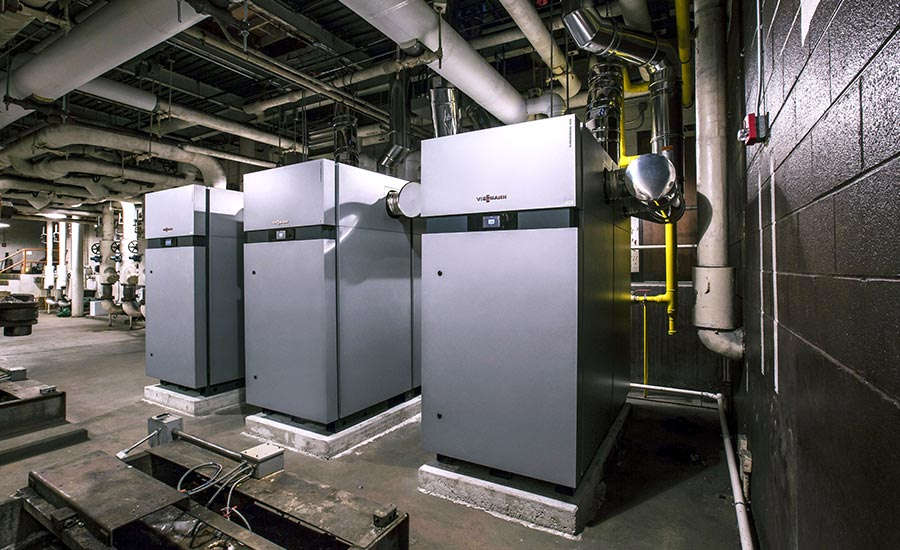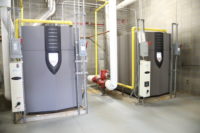The town of Portsmouth, RI, had four schools (two elementary schools, one middle school, and one high school) with outdated, inefficient gas-fired hot water boilers that were becoming expensive to maintain and operate.
In 2015, the school district replaced the elementary school boilers with Viessmann CM2 condensing boilers. In 2016, it was time to tackle the middle and high schools. Both schools have large footprints, with 140,000 sq ft and ~165,000, respectively. Further, the middle school boiler room was located near the center of the building, posing a difficult rigging problem. The challenges were complemented with an opportunity — if the district could meet state efficiency guidelines, it would be eligible for up to a 35% reimbursement through a “Green Initiative” program within the Rhode Island Department of Education’s Necessity of School Construction Program.
Condensing boilers have long been recognized for their energy efficiency. Until recently, none were large enough to meet the Portsmouth Schools’ heating demands. Russ Maciel of ENE Systems — Energy Advisor Group, the energy services firm responsible for the design and installation of new system, seized the opportunity represented by Viessmann’s recent introduction of the Vitocrossal 300 CA3 in the North American market.
The CA3 is a high-mass condensing boiler with multiple heat exchangers and burners. The CA3’s high up to 15:1 turndown ratio in combination with high mass water volume prevents unnecessary cycling, especially in the low-demand shoulder seasons, further reducing operating costs, said officials.
“Viessmann is one of a small nucleus of vendors we work with,” says Maciel. “As a performance contractor, ENE cannot risk anything less than the best. The Vitocrossals deliver the energy efficiency we need to meet our performance targets. And our past experience with Viessmann means we know that maintenance costs will be minimal.”
For each school, ENE recommended three Vitocrossal 300 CA3 3500s for a combined 10.5MMBTU per school. With a 96% efficiency (thermal and combustion), the boilers will provide the district significant fuel savings. They also have another large advantage.
“You can direct pipe them,” Maciel says. “There’s no need for primary and secondary loops. At the scale of these buildings, we’re talking about 8-in, 10-in, and 12-in pipe. We were able to eliminate a lot material and labor. When you factor in the installation savings, it made Viessmann the low-cost option.”
The relatively compact size of the CA3s proved advantageous as well. Matt Murphy of Aramark Facility Services and Portsmouth’s facilities director, shared concerns about the awkward locations of the boiler rooms and the considerable expense of removing the old boilers. “In the high school, we only had to remove one of the old boilers to make room for the three CA3s,” Murphy says.
The middle school, with its centrally located boiler room, could have been more challenging.
“But all we had to pull out was the old combustion control system,” Murphy continued. “Then we lowered the new boilers, with a crane, through the opening left by the old combustion intake louver. We didn’t have to take out any of the old boilers or tear down walls.”
As part of Aramark’s service contract with Portsmouth, Murphy will use the internet to communicate to the Viessmann boilers via a BACnet gateway to the building automation system. This remote access will offer real time insight to how the boilers are operating and allow for adjustments to be made to maximize the efficiency of the system.
Thanks to ENE’s long-term performance contract, which included successful navigation through the R. I. Department of Education Housing Aid process, the district incurred no out of pocket expenses, and did not have to approach taxpayers for funding.
All told, says Maciel, the schools can anticipate a “15% to 20% reduction of fuel costs.”






